Geografi Kelas 11 - Faktor Dinamika Kependudukan - SMA Doa Bangsa | Septian Maulana, S.Pd.
Summary
TLDRIn this video, Septian Maulana explores the topic of population dynamics in geography, specifically focusing on the factors influencing population changes. The three main factors discussed are natality (birth rate), mortality (death rate), and mobility (migration). Each factor is broken down into subtopics, such as the impact of age structure, unemployment, education, and health on natality and mortality. The video also covers the roles of family planning, health awareness, and access to healthcare in shaping these dynamics. Finally, the concept of migration, both permanent and temporary, is explained in relation to population shifts.
Takeaways
- 😀 Population dynamics refers to changes in population structure, number, and distribution, influenced by three main factors: natality, mortality, and mobility.
- 😀 Natality, or birth rate, increases the population and depends on factors like age structure, unemployment rates, education levels, and employment status.
- 😀 Factors that can reduce natality include antinatalism, such as family planning, delayed marriages, and a rise in career-oriented women.
- 😀 Pronatalism, which encourages higher birth rates, includes early marriages, the belief in 'many children, many blessings,' and the idea that children will support parents in old age.
- 😀 Mortality, or death rate, decreases the population and can be measured using crude death rate (CDR) and specific death rate (SDR), which factors in age, gender, or occupation.
- 😀 Promortalism, which promotes higher death rates, includes poor health practices, low nutrition, natural disasters, and inadequate healthcare.
- 😀 Antimortalism, which reduces death rates, involves better health awareness, improved nutrition, more medical personnel, and access to quality healthcare.
- 😀 Migration, or mobility, refers to the movement of people between regions and can either be permanent or temporary, contributing to shifts in population distribution.
- 😀 A society’s natality, mortality, and migration patterns are deeply influenced by cultural, social, and economic factors, such as marriage age, career choices, and healthcare quality.
- 😀 Understanding these population dynamics is crucial for managing societal growth and planning for future development in areas such as education, healthcare, and infrastructure.
Q & A
What is meant by population dynamics?
-Population dynamics refers to the changes in population size, structure, and distribution due to various factors such as birth rates, death rates, and migration.
What are the three main factors that affect population dynamics?
-The three main factors affecting population dynamics are natality (birth rate), mortality (death rate), and migration (mobility).
What is natality and what factors influence it?
-Natality refers to the birth rate or the increase in population due to births. It is influenced by factors like age structure, unemployment, education level, and career status.
How does the age structure affect natality?
-The age structure impacts natality as populations with more people in reproductive age tend to have higher birth rates. Younger populations are generally more likely to have children.
What are the two categories that influence natality?
-The two categories influencing natality are antinatalism (factors that reduce birth rates) and pronatalism (factors that encourage higher birth rates).
Can you give examples of antinatalism factors?
-Examples of antinatalism factors include government family planning programs, delayed marriage, and an increase in women pursuing careers.
What is the relationship between migration and population dynamics?
-Migration, or mobility, involves the movement of people from one area to another, which affects the population size and distribution in both origin and destination regions.
What is the difference between crude death rate and specific death rate (SDR)?
-The crude death rate refers to the total number of deaths in a population within a given year, while specific death rate (SDR) focuses on deaths based on specific factors such as age, gender, and occupation.
What factors influence mortality rates?
-Mortality rates are influenced by healthcare quality, nutrition, the occurrence of natural or man-made disasters, and the availability of medical services.
How do healthcare facilities affect mortality rates?
-Improved healthcare facilities can lower mortality rates by providing better medical care, reducing the risk of death due to preventable diseases and conditions.
Outlines

This section is available to paid users only. Please upgrade to access this part.
Upgrade NowMindmap

This section is available to paid users only. Please upgrade to access this part.
Upgrade NowKeywords

This section is available to paid users only. Please upgrade to access this part.
Upgrade NowHighlights

This section is available to paid users only. Please upgrade to access this part.
Upgrade NowTranscripts

This section is available to paid users only. Please upgrade to access this part.
Upgrade NowBrowse More Related Video
5.0 / 5 (0 votes)





